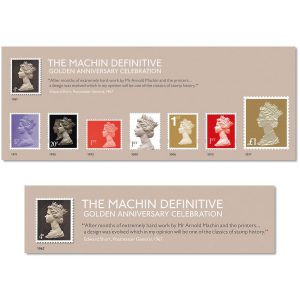This June, Royal Mail celebrated the 50th anniversary of the iconic Machin definitive stamp—first issued on the June 5, 1967—with the launch of six stamps that chart the creation of this classic design.
The Machin definitive is the official name for Britain’s regular stamps and is named after its creator, Arnold Machin.
“Arnold Machin regarded his design and sculpture for the definitive issue stamp as his greatest achievement,” said Dominic Newton, Machin’s nephew and director and trustee of the Machin Arts Foundation. “He saw his task as creating a design with charm and dignity and yet without sentimentality, both a likeness of the Queen and an image of the monarchy. The result was an iconic design that has stood the test of time.”
WHO IS ARNOLD?
Born in Stoke-on-Trent in central England in 1911, Machin would eventually become a renowned artist and sculptor. Coming from a family of pottery workers, he started working at the Minton China Factory, where he stayed for seven years, at the age of 14.
A talented sculptor and modeller, he won scholarships to both the Derby School of Art and Royal College of Art.
Machin also taught in London at the Royal College of Art and was later appointed Master of Sculpture at the Royal Academy Schools. He was elected a member of the Royal Academy of Arts in 1956 and was appointed an Officer of the Order of the British Empire in 1965. He also designed the profile of the Queen that appeared on coinage from 1968-84.
STAMP BY STAMP
The stamps issued on June 5 feature important stages in the evolution of this iconic design. They include:
- January 1966, which was the date of Machin’s preliminary sketch inspired by the Penny Black;
- February 1966, when Machin worked on the mould devised for the coinage head;
- April/May 1966, when he produced an essay (or proof) of the coinage head with symbols;
- October 1966, when he produced a simplified and cropped coinage head;
- August 1966, when John Hedgecoe’s photograph was then used by Machin to model the diadem worn by the Queen (and which was worn by Queen Victoria on the Penny Black); and lastly
- October 1966, when a plaster cast with the diadem but without corsage, which was the final design element, was produced.
An additional miniature sheet of Machin definitives was also issued on June 5. It features the stamp in some of the different formats and colours it has appeared. This sheet includes a new design printed in gold foil at £1 to mark the stamp’s golden anniversary.

The ‘Golden Anniversary Celebration’ sheet features seven stamps: a five- and a 20-pence stamp; four First Class stamps; and a £1 stamp.
MACHIN DEFINITIVE
Prior to 1967, an image of the Queen taken by society photographer Dorothy Wilding was used on stamps.
Following a decision to refresh the Wilding image, a number of artists were invited to submit their ideas to Royal Mail. All artists had to submit a portrait rendering of the Queen as well as some sample stamp designs.
Machin based his initial ideas on work he had previously done for his portrait of the Queen for the decimal coinage, which was based on photographs taken by Lord Snowdon. He produced six portraits and created a total of nearly 70 sketches—far more than anyone else. Several of these greatly resembled the Penny Black, the world’s first adhesive stamp. Some had elaborate frames, and many gave the appearance of a cameo, reflecting Machin’s previous work for Wedgwood.
Nearly all portraits featured the Queen wearing a tiara, as in the Snowdon photographs and on Machin’s effigy for coins.
BAS-RELIEF CAST
Machin was asked to develop his ideas, which as a sculptor he did in the form of a plaster cast.
A recording of the design process was filmed by the then General Post Office for the film Picture to Post, which features Machin as he worked on creating a profile of the Queen as a bas-relief cast. The bas-relief cast was then photographed and used as the image that appeared on the new stamp.
Royal Mail’s design classic was first issued at the four-pence value on June 5, 1967.
Since it was first issued, the portrait has been reprinted an estimated 220 billion times in more than 130 different colours. It’s considered to be one of the most reproduced images in the world.
MACHIN COLOURS
According to Royal Mail, the colours of the Machin stamps have always been specially selected to show off the sculpture to best effect. The current colours are from the “Jubilee Colour Palette” that was introduced in 2013.
Apart from “Royal Mail Red,” which is used for First Class stamps, the names of all new colours include a descriptive word from the natural world, including Harvest Gold, Garnet Red, Slate Grey.
In the 50 years since the introduction of the Machin design for definitives, a remarkable number of different stamps have been produced. There have been more than 550 basic varieties; the differences being mainly in value, colour, shape, security features, phosphor bands or coating, methods of printing and printers.
“We are proud to mark the golden anniversary of the Machin definitive with new stamps showing the evolution of this design classic,” said Royal Mail spokesperson Philip Parker.
For more information, visit royalmail.com/machin50.

